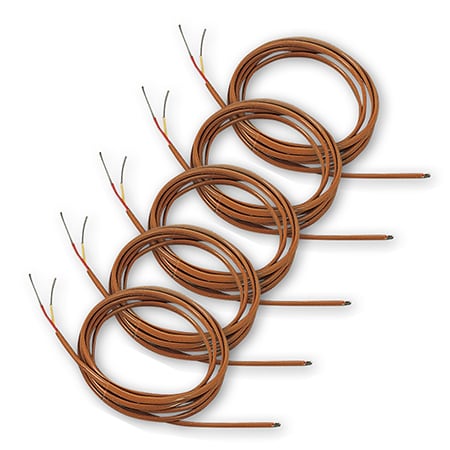Thermocouples are available in different combinations of metals or calibrations. The most common are the “Base Metal” thermocouples known as Types J, K, T, E and N. There are also high temperature calibrations - also known as Noble Metal thermocouples - Types R, S, C and GB
Difference in Thermocouple Types
Each calibration has a different temperature range and environment, although the maximum temperature varies with the diameter of the wire used in the thermocouple. Although thermocouple calibration dictates the temperature range, the maximum range is also limited by the diameter of the thermocouple wire. That is, a very thin thermocouple may not reach the full temperature range.
| Calibration | Temperature Range |
Standard Limits of Error |
Special Limits of Error |
|---|---|---|---|
| J | 0° to 750°C
(32° to 1382°F) |
Greater of 2.2°C
or 0.75% |
Greater of 1.1°C
or 0.4% |
| K | -200° to 1250°C
(-328° to 2282°F) |
Greater of 2.2°C
or 0.75% |
Greater of 1.1°C
or 0.4% |
| E | -200° to 900°C
(-328° to 1652°F) |
Greater of 1.7°C
or 0.5% |
Greater of 1.0°C
or 0.4% |
| T | -250° to 350°C
(-418° to 662°F) |
Greater of 1.0°C
or 0.75% |
Greater of 0.5°C
or 0.4% |
What are the accuracies and temperature ranges of the various thermocouples?
It is important to remember that both accuracy and range depend on such things as the thermocouple alloys, the temperature being measured, the construction of the sensor, the material of the sheath, the media being measured, the state of the media (liquid, solid, or gas) and the diameter of either the thermocouple wire (if it is exposed) or the sheath diameter (if the thermocouple wire is not exposed but is sheathed).
Thermocouple Reference Tables
Thermocouples produce a voltage output that can be correlated to the temperature that the thermocouple is measuring. The documents in the table below provide the thermoelectric voltage and corresponding temperature for a given thermocouple type. Most of the documents also provide the thermocouple temperature range, limits of error and environmental considerations.
Why do thermocouples have different colors?
Click on this link to check the thermocouple color code chartWhy are Type K thermocouples so popular?
Type K thermocouples are so popular because of their wide temperature range and durability. The conductor materials used in Type K thermocouples are more chemically inert than Type T (copper) and Type J (Iron). While the output of Type K thermocouples is slightly lower than Types T, J and E, it is higher than its closest competitor (Type N) and has been in use longer. If you want to learn more about what a K-type thermocouple is, read our full guide.How do I choose between different types?
Each thermocouple type has a designated color-code defined in either ANSI/ASTM E230 or IEC60584. The type can be identified by color as follows:| Calibration | ANSI/ASTM E230 | IEC 60584 |
|---|---|---|
| Type K: | Yellow (+)/ Red (-) | Green (+)/ White (-) |
| Type J: | White (+)/ Red (-) | Black (+)/ White (-) |
| Type T: | Blue (+) / Red (-) | Brown (+) / White (-) |
| Type E: | Purple (+)/ Red (-) | Purple (+) / White (-) |
| Type N: | Orange (+)/ Red (-) | Rose (+) / White (-) |
| Type R: | Black (+)/ Red (-) | Orange (+) / White (-) |
| Type S: | Black (+)/ Red (-) | Orange (+) / White (-) |
| Type B: | Black (+)/ Red (-) | Orange (+) / White (-) |
| Type C: | None established | None established |
Type J Positive (strongly Magnetic), Type K Positive (slightly magnetic).
To determine polarity, connect the thermocouple to a voltmeter capable of measuring millivolts or microvolts and looking for increasing output when the tip is heated slightly.
How do I choose between different types?
Choosing the right type of thermocouple is a mater of matching the thermocouple to your measurement requirement. Here are some areas to take into consideration:- Temperature Range: The different thermocouple types have different temperature ranges. For example, Type T with its Copper leg has a max temperature of 370C or 700F. Type K on the other hand can be used up to 1260C or 2300F.
- Conductor Size: The diameter of the thermocouple wires also needs to be taken into consideration when long duration measurements are needed. For example, Type T thermocouples are rated to 370C/700F, however if your thermocouple has #14AWG wires (.064” Diameter) they are rated for 370C/700F. If your thermocouple has #30AWG wires, that drops to 150C/300F. More information can be found here (See the table on the bottom of page H-7).
- Accuracy: Type T thermocouples have the tightest accuracy of all the base metal thermocouples at ±1C or ±0.75% whichever is greater. This is followed by Type E (±1.7C or 0.5%) and Types J, K and N (±2.2C or 0.75%) for standard limits of error (per ANSI/ASTM E230).



